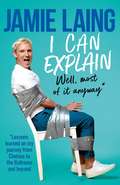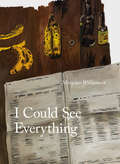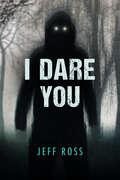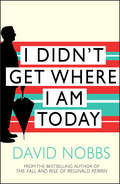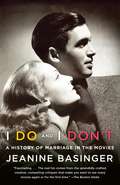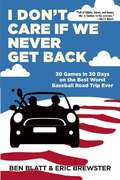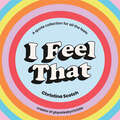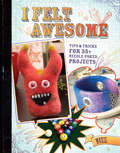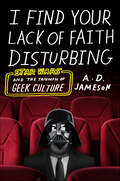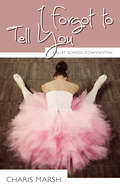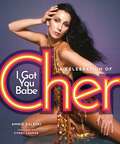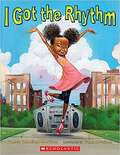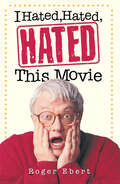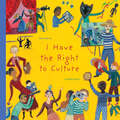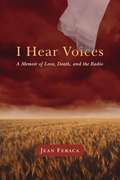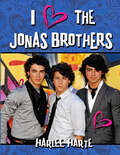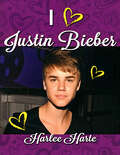- Table View
- List View
I Can Explain
by Jamie LaingThe warm, funny and entertaining memoir of much-loved TV personality and loveable posh boy, Jamie Laing.Funny, charming, and romantic to a fault, everyone loves Jamie Laing. The affectionate and exuberant blonde puppy dog has come a long way - and broken many hearts - since he first graced our screens in 2011 as the joker of the King's Road on Made in Chelsea. Ten years on, he became king of the ballroom making the final of Strictly Come Dancing. Now he's ready to spill the tea - and (McVitie's) biscuits - about life, love and everything in between.From his idyllic upbringing in the countryside to the grey walls of boarding school, Jamie has always had a knack for getting himself into trouble. He reveals how he won popularity at school teaching the rest of the boys the proper way to ... [PARENTAL ADVISORY]. He hilariously recounts blagging his way into a casino aged 17, and winning so much money his mother thought he was a drug dealer. Jamie has been equally lucky with ladies, but not always quite the romantic hero he had in mind - unless sitting lovelorn outside a girlfriend's halls begging to be taken back while fending off abuse from drunk students calling out 'Made in Chelsea twat' counts as heroism?Jamie also writes movingly about his struggles off camera, which left him crippled with anxiety and led to his eventual burnout. Throughout it all he opens up about the importance of friendship and how his two ride-or-dies, Georgie and Spencer, have always been there for him. They've enabled Jamie to thrive as a confectionery king and genuinely change lives with his Private Parts podcast, while not letting him forget that he took part in The Great Celebrity Bake Off for Stand Up To Cancer despite not knowing how to pronounce the word 'meringue'. Candid, entertaining, and almost always ridiculous, this is the real Jamie Laing.
I Can Explain
by Jamie LaingThe warm, funny and entertaining memoir of much-loved TV personality and loveable posh boy, Jamie Laing.Funny, charming, and romantic to a fault, everyone loves Jamie Laing. The affectionate and exuberant blonde puppy dog has come a long way - and broken many hearts - since he first graced our screens in 2011 as the joker of the King's Road on Made in Chelsea. Ten years on, he became king of the ballroom making the final of Strictly Come Dancing. Now he's ready to spill the tea - and (McVitie's) biscuits - about life, love and everything in between.From his idyllic upbringing in the countryside to the grey walls of boarding school, Jamie has always had a knack for getting himself into trouble. He reveals how he won popularity at school teaching the rest of the boys the proper way to ... [PARENTAL ADVISORY]. He hilariously recounts blagging his way into a casino aged 17, and winning so much money his mother thought he was a drug dealer. Jamie has been equally lucky with ladies, but not always quite the romantic hero he had in mind - unless sitting lovelorn outside a girlfriend's halls begging to be taken back while fending off abuse from drunk students calling out 'Made in Chelsea twat' counts as heroism?Jamie also writes movingly about his struggles off camera, which left him crippled with anxiety and led to his eventual burnout. Throughout it all he opens up about the importance of friendship and how his two ride-or-dies, Georgie and Spencer, have always been there for him. They've enabled Jamie to thrive as a confectionery king and genuinely change lives with his Private Parts podcast, while not letting him forget that he took part in The Great Celebrity Bake Off for Stand Up To Cancer despite not knowing how to pronounce the word 'meringue'. Candid, entertaining, and almost always ridiculous, this is the real Jamie Laing.
I Could See Everything: The Paintings of Margaux Williamson
by Margaux Williamson'Like all my favourite art, these paintings bring out that covetous feeling - I want to wear them, dance to them, show them off as an example of how life feels to me: dirty, dumb, terrifying, spiritual and so funny.'- Miranda July 'In a time of ironic detachment, Margaux Williamson is a painter of extreme candour, but the violence of her vision is cut with wonder and love. Sometimes she recalls Philip Guston, sometimes she's like a Pittsburgh-born Van Gogh; usually she reminds me of nobody at all. Seeing as she sees feels like waking up.' - Ben Lerner In a world where the image of a painting on a computer screen can be as real as a painting hanging in a gallery, I Could See Everything, the breakthrough body of work by acclaimed painter, filmmaker and social artist Margaux Williamson, appears here both as a strange vision and one that feels so familiar and inevitable. This suite of forty-six paintings, selected and curated by the Road at the Top of the World Museum for their tenth anniversary, shares the gallery's preoccupation with, as curator Ann Marie Peña says, darkness as both geographical condition and conceptual idea. In collecting all forty-six works alongside essays by David Balzer, Mark Greif, Chris Kraus and Leanne Shapton and an introduction by the curator, this catalogue transcends the boundary between the authentic and the imaginary, and collapses the distinction between art show, museum catalogue and document of something astonishing that also never was.
I Dare You (Orca Soundings)
by Jeff RossWhat happens when a supernatural hoax turns into a real-life crime? Sixteen-year-old Rainey is surprised when a video he made of a schoolyard fight goes viral. Two schoolmates, Jordan and Rowan, convince him to make another one, this time about a mysterious figure in the woods. Soon rumors are circulating that someone is out there kidnapping kids. Or maybe it’s a ghost. The teens are thrilled with the attention their prank is getting and are setting up a follow-up video when things go horribly wrong. A local woman, convinced that the ghost is related to the nightmares she’s been having for years, drives out to the area to investigate. The sight of Rowan in costume staggering across her path causes her to drive off the road. When the police start asking questions, Jordan and Rowan abandon Rainey. No one else knows what really happened but will a guilty conscience force Rainey to admit to his part in the accident or will he keep quiet?
I Didn't Come Here to Make Friends: Confessions of a Reality Show Villain
by Courtney Robertson Deb BaerIn I Didn’t Come Here to Make Friends former Bachelor “villain” and season 16 winner Courtney Robertson shares her story of love and heartbreak, and the reality of appearing on reality TV. For the first time ever, a former Bachelor contestant takes us along on her journey to find love and reveals that “happily ever after” isn't always what it seems.
I Didn't Get Where I Am Today
by David NobbsAs a small boy David Nobbs survived the Second World War unscathed, until his bedroom ceiling fell on him when the last bomb to be dropped on Britain by the Germans landed near his home. It was the nearest he came to the war, but National Service would later make him one of Britain's most reluctant soldiers. It was an unforgettable and often unpleasant experience.As a struggling writer, David was catapulted into the thrilling world of satire at the BBC when he rang THAT WAS THE WEEK THAT WAS with a joke and got through to David Frost, who sent a taxi for the joke. He never looked back. His greatness as a modern comic writer was confirmed by the publication of THE FALL AND RISE OF REGINALD PERRIN, which he adapted into the immensely successful television series that has entered the fabric of British cultural life, through phrases, images and brilliant humour. A mesmerising, beautifully told tale of life in writing and comedy, I DIDN'T GET WHERE I AM TODAY is the hilarious, poignant and very personal story of David Nobbs' life, which also describes some of the most famous comedians of the last century and captures a golden age of British television.
I Died a Million Times: Gangster Noir in Midcentury America
by Robert MiklitschIn the 1950s, the gangster movie and film noir crisscrossed to create gangster noir. Robert Miklitsch takes readers into this fascinating subgenre of films focused on crime syndicates, crooked cops, and capers. With the Senate's organized crime hearings and the brighter-than-bright myth of the American Dream as a backdrop, Miklitsch examines the style and history, and the production and cultural politics, of classic pictures from The Big Heat and The Asphalt Jungle to lesser-known gems like 711 Ocean Drive and post-Fifties movies like Ocean’s Eleven. Miklitsch pays particular attention to trademark leitmotifs including the individual versus the collective, the family as a locus of dissension and rapport, the real-world roots of the heist picture, and the syndicate as an octopus with its tentacles deep into law enforcement, corporate America, and government. If the memes of gangster noir remain prototypically dark, the look of the films becomes lighter and flatter, reflecting the influence of television and the realization that, under the cover of respectability, crime had moved from the underworld into the mainstream of contemporary everyday life.
I Do and I Don't: A History of Marriage in the Movies
by Jeanine BasingerFrom one of our leading film historians and interpreters: a brilliantly researched, irresistibly witty, delightfully illustrated examination of "the marriage movie"; what it is (or isn't) and what it has to tell us about the movies--and ourselves.As long as there have been feature movies there have been marriage movies, and yet Hollywood has always been cautious about how to label them--perhaps because, unlike any other genre of film, the marriage movie resonates directly with the experience of almost every adult coming to see it. Here is "happily ever after"--except when things aren't happy, and when "ever after" is abruptly terminated by divorce, tragedy . . . or even murder. With her large-hearted understanding of how movies--and audiences--work, Jeanine Basinger traces the many ways Hollywood has tussled with this tricky subject, explicating the relationships of countless marriages from Blondie and Dagwood to the heartrending couple in the Iranian A Separation, from Tracy and Hepburn to Laurel and Hardy (a marriage if ever there was one) to Coach and his wife in Friday Night Lights. A treasure trove of insight and sympathy, illustrated with scores of wonderfully telling movie stills, posters, and ads.
I Don't Care If We Never Get Back: 30 Games in 30 Days on the Best Worst Baseball Road Trip Ever
by Ben Blatt Eric BrewsterBen, a sports analytics wizard, loves baseball. Eric, his best friend, hates it. But when Ben writes an algorithm for the optimal baseball road trip--an impossible dream of seeing every pitch of 30 games in 30 stadiums in 30 days--who will he call on to take shifts behind the wheel, especially when those shifts include nineteen hours straight from Phoenix to Kansas City? Eric, of course. Will Eric regret it? Most definitely. On June 1, 2013, Ben and Eric set out to see America through the bleachers and concession stands of America's favorite pastime. Along the way, human error and Mother Nature throw their mathematically optimized schedule a few curveballs. A mix-up in Denver turns a planned day off in Las Vegas into a twenty-hour drive, and a summer storm of biblical proportions threatens to make the whole thing logistically impossible, if they don't kill each other first. I Don't Care If We Never Get Back is a charming, insightful, and hilarious book about the limits of fandom and the limitlessness of friendship.
I Don't Know Sh*t About F*ck: The Official Ozark Guide to Life by Ruth Langmore
by Ruth LangmoreDiscover the rich philosophy of Ruth Langmore, everyone&’s favorite foul-mouthed criminal, in this irreverent, playful, and profanity laden &“guide to life&” inspired by the hit Netflix television series Ozark. Toughened by both her criminal ties and her dedication to her family, Ruth Langmore is guided by one principal: She doesn&’t know sh*t about f*ck. Far from being willfully ignorant, Ruth admits that she has much to learn, forming a personal philosophy based on a positive attitude toward lifelong learning. A born survivor, Ruth knows a thing or two about persevering through life&’s most difficult situations. In this blunt but profound guide to life, Ruth herself shows you how to navigate your own personal blind sides, while simultaneously learning the skills you need to thrive. So, listen motherfu*kers, and forget everything you think you know.
I Don't Really Love You: And Other Gentle Reminders of Existential Dread in Your Everyday Life
by Alex BeyerGo from aww to awful! with I Don't Really Love You, a darkly humorous collection of adorable pet photography and soul-crushing one-liners, based on the popular Instagram @365DaysofDread. Drawing on the black humor of author Alex Beyer, I Don't Really Love You takes readers on a journey from delightful to depressing (and back again!). Dead pan captions, from "Birthdays don't matter" to "Inadequacy haunts me endlessly," peek out from behind the forms of calm cats and happy-go-lucky puppies, creating an unexpected contrast and offbeat appeal. Pet lovers and humor lovers will be captivated in equal measure, with more than 75 full-color photographs of cats and dogs in a range of breeds, alongside an off-beat, subversive voice. With the perfect attitude for our rapidly changing world, this quirky book will make readers laugh out loud (after sending them crawling under the covers to contemplate their existence).
I Feel That: A quote collection for all the feels
by Christina ScotchFrom popular Instagram artist @QuotesByChristie, an inspiring and colorful quote collection for all of your ups and downs. Quotes are instant sympathy. A good quote says, &“I&’ve been there, too,&” in just a few words. And the perfect quote in the perfect moment can be just the reminder you need that you&’re not alone, and you&’re going to get through this. That is why Christina Scotch started QuotesByChristie, her popular Instagram page—to reach out across the Internet void and embrace all of the people going through it, too. In this colorful collection, Scotch shares fan favorites and all new material to hit all of your highs and lows. Perfect for birthdays, graduations, and any other gift-able occasion, I Feel That is sure to be an inspiration for readers everywhere.
I Felt Awesome: Tips and Tricks for 35+ Needle-Poked Projects
by MoxieIt's OK to play with needles I Felt Awesome shows you how to turn traditional needle-felting techniques into irreverent felted fun. Moxie's playful and cheeky sense of humor will needle you into taking your felting beyond traditional motifs, and decorate yourself and your home with feisty designs of wearable, playable and coffee table-worthy objects. Get started with: • Step-by-step instructions for 35 projects, including a felted spike bracelet, bendy and boingy toys and larger-than-life home décor featuring fruit and more. • Traditional needle-felting techniques lay the groundwork for uncommon materials like magnets, plastic toy parts and bendable wires. • Wool roving and felting needles are all you need to get started-helpful tips show handy shortcuts that still produce fantastic results. Get friendly with fiber, and tell all your friends "I Felt Awesome."
I Find Your Lack of Faith Disturbing: Star Wars and the Triumph of Geek Culture
by A. D. Jameson"Funny, incisive, and timely ... Jameson does for geeks what geek culture does for its superheroes: he takes them seriously, respects their power, and refuses to hide his deep affection." —Lawrence Kasdan, co-screenwriter of The Empire Strikes Back, Return of the Jedi, The Force Awakens, and Solo: A Star Wars StoryIn I Find Your Lack of Faith Disturbing, A. D. Jameson takes geeks and non-geeks alike on a surprising and insightful journey through the science fiction, fantasy, and superhero franchises that now dominate pop culture. Walking us through the rise of geekdom from its underground origins to the top of the box office and bestseller lists, Jameson takes in franchises like The Lord of the Rings, Guardians of the Galaxy, Harry Potter, Star Trek, and, in particular, Star Wars—as well as phenomena like fan fiction, cosplay, and YouTube parodies. Along the way, he blasts through the clichés surrounding geek culture: that its fans are mindless consumers who will embrace all things Spider-Man or Batman, regardless of quality; or that the popularity and financial success of Star Wars led to the death of ambitious filmmaking.A lifelong geek, Jameson shines a new light on beloved classics, explaining the enormous love (and hate) they are capable of inspiring in fan and non-fan alike, while exploding misconceptions as to how and why they were made. I Find Your Lack of Faith Disturbing tells the story of how the geeks have inherited the earth.
I Forgot to Tell You: Ballet School Confidential
by Charis MarshThe students of VIBA face a new ballet, potential scholarships, and increasing drama within the academy. The students of Vancouver International Ballet Academy are preparing to perform the ballet Coppelia. A ballet about dolls, love, and trickery, Coppelia doesn’t have a moral, and neither do the rehearsals. If Taylor, Julian, Alexandra, and Kaitlyn don’t rise to meet the challenges this ballet is putting them through, they might not make it on stage. The dancers might be fully alive, but they have more than enough real-life drama to keep them busy. The casting of the principal role of Swanhilda keeps getting changed, but is it really about who’s the best dancer right now, or is something else influencing the casting decisions?Summer school acceptances and rejections are in, but who’s telling the truth about where they’re going? And who’s coming back to VIBA after the summer?
I Fought the Law: Photographs by Olivia Locher of the Strangest Laws from Each of the 50 States
by Olivia Locher Eric ShinerStrange, outdated laws from each of the 50 U.S. states—some overturned, some still on the books, and some merely the stuff of legends—are depicted with sly wit by Olivia Locher. Incisive, ironic, and gorgeous, these images will appeal to art buffs and trivia fans alike. A foreword from American poet Kenneth Goldsmith and an interview with the artist by Eric Shiner, former director of the Andy Warhol Museum, contextualize rising-star Locher's photography. From serving wine in teacups in Kansas to licking a toad in Kentucky or perming a child's hair in Nebraska, breaking the law has never looked so good.
I Got You Babe: A Celebration of Cher
by Annie ZaleskiCovering her life and sixty-year career from Sonny & Cher to show-stopping solo performer, award-winning actress, fashion icon, and beyond, this is a glorious retrospective of one of the world&’s most enduring entertainers, Cher. Featuring a foreword by Cyndi Lauper! Commemorating six decades since her first #1 hit in 1965, I Got You Babe captures Cher&’s one-of-a-kind life. Written by award-winning writer and editor Annie Zaleski, this celebration of the fearless, down-to-earth &“Goddess of Pop&” explores key moments in her life and career in words and photos. Among the topics covered: Her 50-year friendship with fellow diva Tina Turner, which began in 1975 when they performed &“Shame, Shame, Shame&” together. Her story of creating a &“revenge dress&” with designer Bob Mackie for the 1986 Oscars after being snubbed for a nomination for her performance in Mask. The night in 1989 she made the Navy wish it could &“Turn Back Time&” by arriving at the USS Missouri to film her video not wearing the coveralls they expected but a barely-there fishnet bodysuit. Cher&’s unfiltered social media presence. From classic posts like &“BREAKING NEWS: IM BEING BURIED IN MY FISHNETS&” to weighing in on issues she believes in. When Cher learned about Kaavan, dubbed &“the world&’s loneliest elephant.&” The creature was kept in chains in a zoo in Pakistan and forced to perform for decades. After fans brought the problem to her attention, Cher eventually helped get him moved in 2021, and her efforts were captured in a Smithsonian documentary. Amid these moments are photo after photo of some of the most eye-popping outfits ever worn in life and on stage. As an avid clothes horse who wasn&’t afraid to wear a see-through dress to the Met Gala in 1974, Cher&’s many looks will be given their due in this engaging, career-spanning retrospective.
I Got the Rhythm
by Frank Morrison Connie Schofield-MorrisionOn a simple trip to the park, the joy of music overtakes a mother and daughter. The little girl hears a rhythm coming from the world around her- finally busting out in an impromptu dance, which all the kids join in on!
I Hated, Hated, Hated This Movie
by Roger EbertThe Pulitzer Prize–winning film critics offers up more reviews of horrible films.Roger Ebert awards at least two out of four stars to most of the more than 150 movies he reviews each year. But when the noted film critic does pan a movie, the result is a humorous, scathing critique far more entertaining than the movie itself.I Hated, Hated, Hated This Movie is a collection of more than 200 of Ebert’s most biting and entertaining reviews of films receiving a mere star or less from the only film critic to win the Pulitzer Prize. Ebert has no patience for these atrocious movies and minces no words in skewering the offenders.Witness: Armageddon * (1998)—The movie is an assault on the eyes, the ears, the brain, common sense, and the human desire to be entertained. No matter what they’re charging to get in, it’s worth more to get out.The Beverly Hillbillies * (1993)—Imagine the dumbest half-hour sitcom you’ve ever seen, spin it out to ninety-three minutes by making it even more thin and shallow, and you have this movie. It’s appalling.North no stars (1994)—I hated this movie. Hated hated hated hated hated this movie. Hated it. Hated every simpering stupid vacant audience-insulting moment of it. Hated the sensibility that thought anyone would like it. Hated the implied insult to the audience by its belief that anyone would be entertained by it.Police Academy no stars (1984)—It’s so bad, maybe you should pool your money and draw straws and send one of the guys off to rent it so that in the future, whenever you think you’re sitting through a bad comedy, he could shake his head, chuckle tolerantly, and explain that you don't know what bad is.Dear God * (1996)—Dear God is the kind of movie where you walk out repeating the title, but not with a smile.The movies reviewed within I Hated, Hated, Hated This Movie are motion pictures you’ll want to distance yourself from, but Roger Ebert’s creative and comical musings on those films make for a book no movie fan should miss.
I Have the Right to Culture (I Have the Right #3)
by Alain SerresFrom the author and illustrator duo who created the award-winning I Have the Right to Be a Child and I Have the Right to Save My Planet comes this beautifully illustrated third book in the series. I Have the Right to Culture explores a child’s right to be curious and to experience all of humanity’s shared knowledge, including music, art, dance and much more. When a child is born, they learn the language of their parents, they sing the songs of their grandparents and they eat the delicious food that their family prepares. They also start to wonder about the lives of other children who live far away. What languages do they speak? What songs do they sing? And what games do they play? Every child has the right to learn about the world they live in, including its history and its inventions. Every child has the right to learn about artists, about writers, about potters and photographers and architects, about musicians and dancers and poets. All of humanity’s treasures are for sharing, and every child has the right to know about what has come before them! Children have the right to partake in culture as proclaimed in the United Nations Convention on the Rights of the Child. Told from the perspective of a child, this colorful and vibrant book explores what it means to be a child who has the right to find beauty in their world. Key Text Features further reading Correlates to the Common Core State Standards in English Language Arts: CCSS.ELA-LITERACY.RI.K.1 With prompting and support, ask and answer questions about key details in a text. CCSS.ELA-LITERACY.RI.K.6 Name the author and illustrator of a text and define the role of each in presenting the ideas or information in a text. CCSS.ELA-LITERACY.RI.K.7 With prompting and support, describe the relationship between illustrations and the text in which they appear (e.g., what person, place, thing, or idea in the text an illustration depicts). CCSS.ELA-LITERACY.RI.1.8 Identify the reasons an author gives to support points in a text.
I Haven’t Been Entirely Honest with You: From bestselling author and the nation's favourite comedian
by Miranda HartPacked with hard-won wisdoms and gentle truths, this is Miranda’s honest exploration of the lessons she has learned on her journey from illness to recovery'A bombshell, moving, inspirational. Hart passes on the tips that helped her emerge from psychological as much as physical doldrums. No comedian, female or male, has been so taken to the nation’s bosom since Victoria Wood' Independent'Irrepressible and joyous. Taking us affectionately by the hand, Miranda takes us through her ten-year journey to deep self-knowledge' Daily Mail‘A wonderful book, filled with treasure’ Julia Samuel'A raw and poignant account. Miranda is more of an everywoman than ever before' The Times'Miranda's account of slowly letting her guard down and being vulnerable is sweet and moving, and proof that happiness is possible even in the most trying times' Guardian----Hello to you, I am with news. I have a new book: I Haven’t Been Entirely Honest With You. I know – what an intriguing title!Basically, I have had an unexpectedly difficult decade – there have been surprising joys, but also deep revelations and challenging lows. I shall be honest about those, because what I discovered in the difficult times were my, what I call, treasures.Treasures – practical tools, values, ways, answers researched from some great scientists, neuroscientists, therapists, sociologists (all the ‘ists’) out there, that have genuinely led to a sense of freedom, joy, peace and physical recovery I never would have thought possible.Life now, amazingly, with what I will share, is – SUCH FUN! (always important to quote your own catch phrases. . .) If you fancy having a read, then I hope my story might help your story. After all, we are in this beautiful, mysterious, challenging life together. Rest assured there are funny stories along the way – we will have a laugh too, my dear reader chum.Oh, and I couldn’t possibly say if there is a love story in it . . . (There is – shush). Exciting.----Sunday Times bestseller, October 2024
I Hear Voices
by Jean FeracaJean Feraca’s road to self-fulfillment has been as quirky and demanding as the characters in her memoir. A twenty-five-year veteran of public radio broadcasting, Feraca is also a writer and a poet. She is a talk show host beloved for her unique mixture of the humanities, poetry, and journalism, and is the creator of the pioneering international cultural affairs radio programHere on Earth: Radio without Borders. In this searing memoir, Feraca traces her own emergence. She pulls back the curtain on her private life, revealing unforgettable portraits of the characters in her brawling Italian American family: Jenny, the grandmother, the devil woman who threw Casey Stengel down an excavation pit; Dolly, the mother, a cross between Long John Silver and the Wife of Bath who in battling mental illness becomes the scourge of a Lutheran nursing home; and Stephen, the brilliant but troubled older brother, an anthropologist who was adopted into a Sioux tribe. While building a career and raising two sons, Feraca learns empathy when she faces her brother’s cancer and her mother’s dementia. As she finds her voice and sense of self, her story moves far afield: a sojourn in a Benedictine monastery, a courtship through the California wine country, a dip into Dante’s hell in Italy’s Appalachia, an expedition in the Peruvian Amazon, a day under a huppah as she marries a Jewish scientist. Unique, eccentric, and distinctive,I Hear Voicesis a memoir that tells a universal story of a woman evolving to fully embrace her life and the world. Best of all, from the many voices in Feraca’s life emerges one that will be familiar to old fans-and delightful to new ones-leaping off the written page as compelling, eloquent, and surprising as ever. Outstanding Book, selected by the American Association of School Librarians, and Best Books for General Audiences, selected by the Public Library Association Winner, August Derleth Book-length Nonfiction Award, The Council for Wisconsin Writers
I Heart Jennifer Coolidge: A Celebration of Your Favorite Pop Culture Icon
by Lauren Emily WhalenAn adoring, celebratory tribute to the one, the only, Jennifer Coolidge, that all-at-once captures her unique personality, engaging life story, smart and sassy life lessons, and special brand of humor that's quickly made JC one of America's most beloved stars and pop culture icons. Whether we remember Jennifer Coolidge as the hilariously ditzy manicurist Paulette Bonafonté in Legally Blonde, as the seductress Stifler&’s Mom from American Pie, or as the totally unaware and fragile basket case Tanya McQuoid in The White Lotus, these scene-stealing performances have shown her many dimensions as a comic actor and her craft is palpable—Jennifer has finally reached the pop culture stardom she so rightly deserves. To say the comedy legend is having a comeback would be an understatement. Jennifer has been well known to her fans for decades since her performances in American Pie, Legally Blonde, and numerous appearances in Christopher Guest mockumentaries (Best in Show, A Mighty Wind), but it was her recent roles in The White Lotus and The Watcher that made people stand up and take notice of this hilarious actor and all-around amazing talent. Her fearless and entertaining characters have earned her an Emmy, a Golden Globe, and a Critics' Choice Award, and she has been lovingly parodied by Chloe Fineman in two SNL sketches.I Heart Jennifer Coolidge is a loving tribute to an incredible icon that recounts Jennifer&’s engaging life story, her numerous roles, guest star appearances, small screen success stories, and, of course, sage wisdom and sassy advice we can all learn from this iconic actor. It&’s a lively, illustrated love letter to JC that&’s part biography, part words of wisdom, part life lessons, that highlights this national treasure with confidence, personality, and all the humor.
I Heart Jonas Brothers (I Heart Ser.)
by Harlee HarteHarlee Harte writes the celebrity column for her high school newspaper where she gets to meet and greet the hottest teen sensations, write about her idols, and hang out at the hippest places. Her friends pop in and offer advice on the latest fashions, beauty tips, music, celeb sightings, and how to deal with parents, school, crushes, and friends.Harlee' s latest assignment is getting the inside scoop on the Jonas Brothers— Nick, Joe, and Kevin– who starred in the Disney movie Camp Rock and its sequel Camp Rock 2: The Final Jam. The brothers also produced the top ten singles “ Burnin' Up” and “ Tonight” as well as number one albums A Little Bit Longer and Lines, Vines, and Trying Times.In this fun-filled book, Harlee shares gossipy facts about the brothers and the songs and movies that made them famous. Get all the details about this trio, including their thoughts on dating, their likes and dislikes, and their quick rise to fame. Then, take the quizzes at the end of the book to find out how much you really know about Joe, Kevin, and Nick!
I Heart Justin Bieber
by Harlee HarteHarlee Harte writes the celebrity column for her high school newspaper where she gets to meet and greet the hottest teen sensations, write about her idols, and hang out at the hippest places. Her friends pop in and offer advice on the latest fashions, beauty tips, music, celeb sightings, and how to deal with parents, school, crushes, and friends.Harlee' s latest assignment is getting the inside scoop on Justin Bieber, who was the first artist to have seven songs from a debut record chart on the Billboard Hot 100. Justin achieved international success with his debut album, My World and wrote and performed worldwide hits "Baby” and “ Boyfriend.” Justin also had number one albums My World 2.0 and Never Say Never. In this fun-filled book, Harlee shares gossipy facts about Justin and the songs that made him famous. Get all the details about Justin, including his thoughts on dating, his likes and dislikes, and his quick rise to fame. Then, take the quizzes at the end of the book to find out how much a Belieber you really are!
